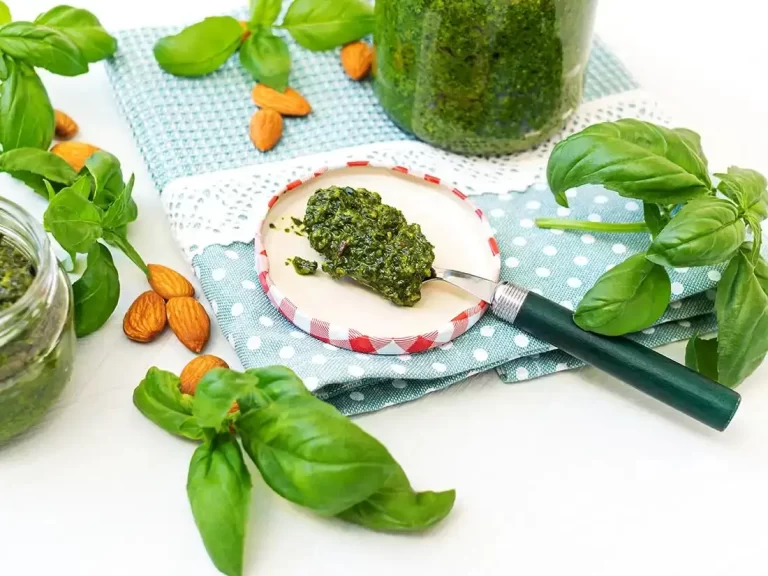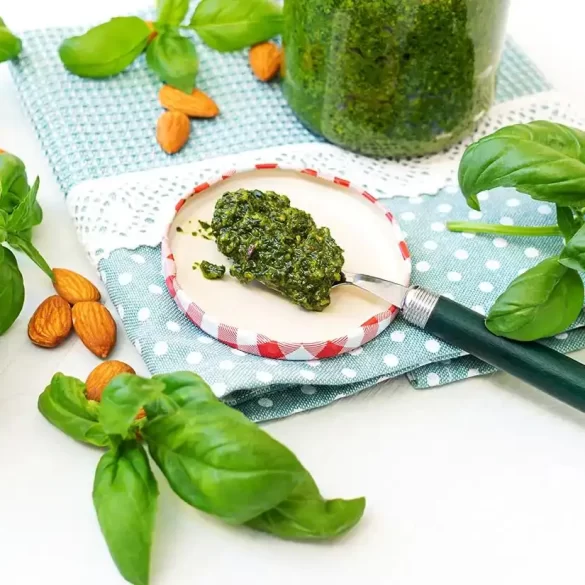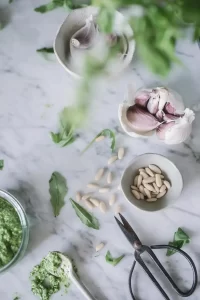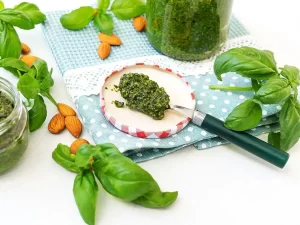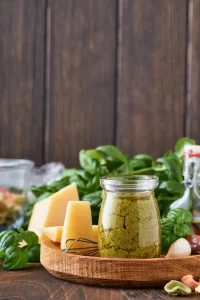Table of Contents
If you’re looking for a delicious and versatile sauce that doesn’t require expensive pine nuts, you’re in the right place. This Homemade Pesto Without Pine Nuts recipe is the perfect solution for those who want a classic pesto flavor without the cost or potential allergens of pine nuts. Whether you’re avoiding pine nuts due to dietary restrictions or simply don’t have them on hand, this recipe delivers all the bold, herby, and cheesy flavors you love.
In this guide, we’ll walk you through everything you need to know about making pesto without pine nuts, along with helpful tips, creative variations, and ideas for serving this delicious sauce.
How to Make Pesto Without Pine Nuts
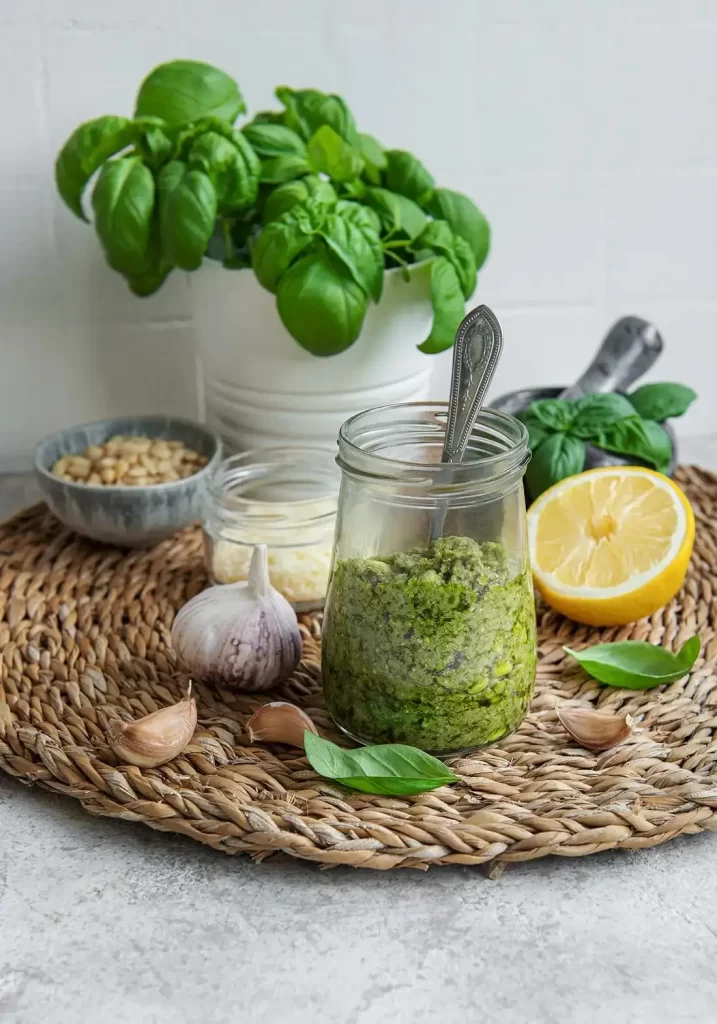
Ingredients
Here’s what you’ll need to make pesto sauce without pine nuts:
- 2 cups fresh basil leaves (packed): The aromatic and flavorful base of the pesto, providing its signature herbal taste.
- 1/2 cup grated Parmesan cheese (or a vegan alternative): Adds a rich, salty, and umami flavor to the sauce.
- 1/2 cup extra virgin olive oil: The liquid gold that binds the ingredients and creates a smooth, creamy texture.
- 1/3 cup toasted sunflower seeds (or another nut/seed alternative): Adds nuttiness, texture, and a subtle crunch to the pesto.
- 2 cloves garlic (peeled): Brings a sharp, savory kick to balance the flavors.
- 1 tablespoon lemon juice (freshly squeezed): Brightens the pesto with a tangy, citrusy note.
- Salt and pepper to taste: Enhances and balances all the flavors, ensuring the perfect seasoning. These ingredients come together to create a vibrant and rich pesto sauce that’s just as delicious as the traditional version.
Instructions to Make Pesto Without Pine Nuts
Follow these simple steps to whip up your own pesto without pine nuts:
- Toast the sunflower seeds: Heat a small skillet over medium heat. Add the sunflower seeds and toast them for 2-3 minutes, stirring frequently, until golden brown and fragrant. Remove from heat and let cool.
- Blend the ingredients: In a food processor or blender, combine the basil leaves, toasted sunflower seeds, garlic, Parmesan cheese, and lemon juice. Pulse a few times until the mixture begins to break down.
- Add olive oil: With the food processor running, slowly drizzle in the olive oil. Blend until the mixture is smooth and creamy. You can adjust the texture by adding more olive oil if needed.
- Season to taste: Add salt and pepper to your liking. Blend briefly to incorporate the seasoning.
- Serve or store: Use your pesto immediately, or transfer it to an airtight container and store it in the refrigerator for up to one week. For longer storage, freeze the pesto in an ice cube tray and transfer the cubes to a freezer-safe bag once frozen.
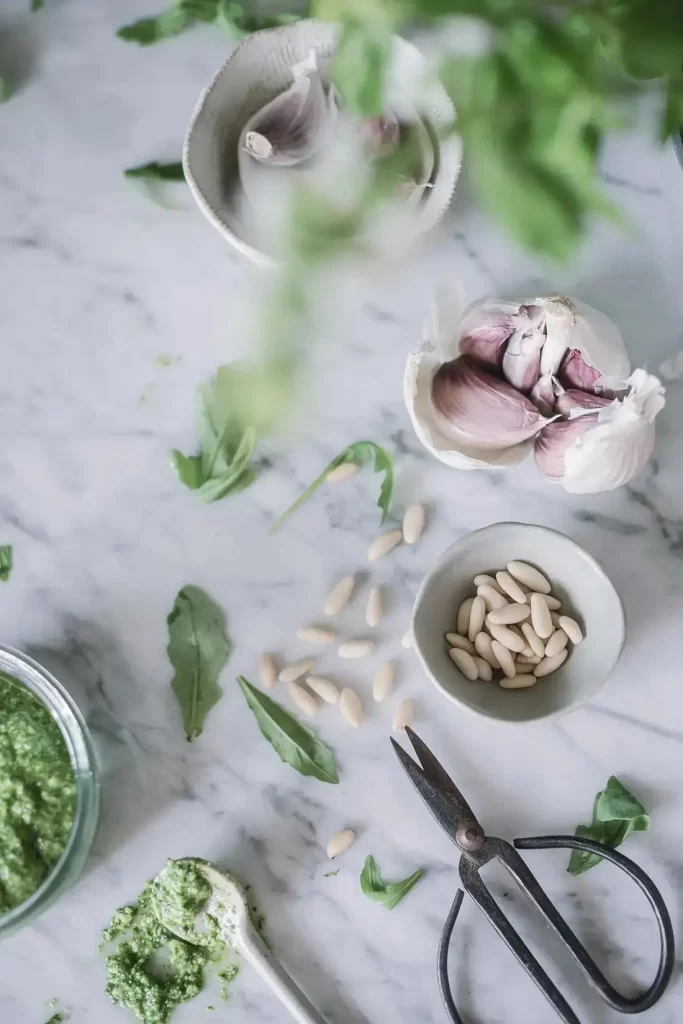
Tips for the Perfect Pesto Without Pine Nuts
- Choose fresh basil: Fresh, fragrant basil leaves are the star of this recipe. Avoid wilted or discolored leaves for the best flavor.
- Toast your seeds/nuts: Toasting enhances the flavor and adds a subtle nuttiness to your pesto.
- Avoid Over-blending: Over-processing can cause the pesto to brown. Pulse gently to maintain a bright green color.
- Experiment with textures: For a chunkier pesto, pulse the ingredients instead of blending them into a smooth paste.
- Adjust for dietary needs: For a vegan pesto, use nutritional yeast or vegan Parmesan instead of traditional cheese.
How to Use Pesto Without Pine Nuts
Pesto sauce without pine nuts is as versatile as it is flavorful. Here are some of the best ways to enjoy it:
- Pasta dishes: Toss with cooked pasta for an easy weeknight dinner.
- Sandwiches and wraps: Use as a spread to add a burst of flavor to your favorite sandwiches like Chicken Claw Sandwich.
- Pizza topping: Swap out traditional marinara for pesto on your next pizza night.
- Salad dressing: Mix with a bit of vinegar or yogurt to create a delicious salad dressing.
- Vegetables: Drizzle over roasted or steamed veggies for an herby finish.
- Dip: Serve with crackers or raw vegetables for a quick appetizer.
Variations of Pesto Without Pine Nuts
Get creative with your pesto recipe by trying these variations:
- Nut-Free Pesto: Replace sunflower seeds with pumpkin seeds or omit seeds/nuts entirely for a completely nut-free option.
- Spinach Pesto: Substitute half the basil with fresh spinach for a milder flavor and added nutrients.
- Vegan: Replace Parmesan with nutritional yeast or vegan cheese.
- Arugula Pesto: Add arugula to give the pesto a peppery kick.
- Cilantro Pesto: Swap out basil for cilantro to create a bright, tangy sauce.
- Cheese-Free Pesto: Use nutritional yeast instead of Parmesan for a dairy-free alternative.
- Spicy Pesto: Add a pinch of red chili flakes for heat.
- Citrus Twist: Incorporate lemon or lime zest for a fresh kick.
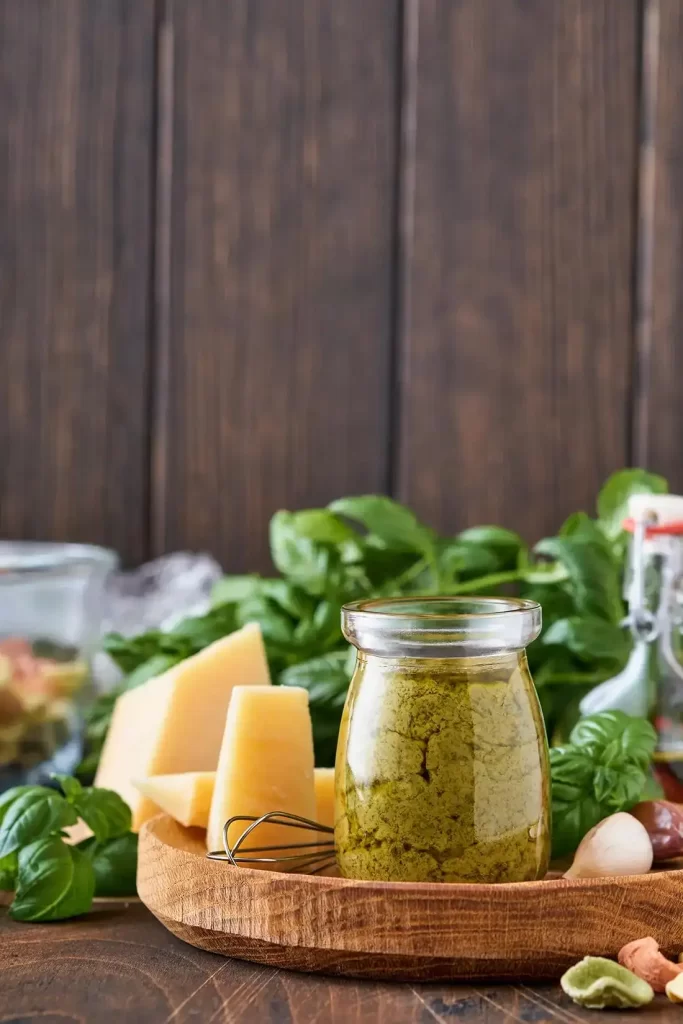
FAQs
Can I make pesto without nuts or seeds?
Yes! Simply omit the nuts or seeds and increase the Parmesan cheese slightly for texture. You may need to adjust the olive oil to reach your desired consistency.
How do I store pesto without pine nuts?
Store your pesto in an airtight container in the refrigerator for up to one week. For longer storage, freeze it in an ice cube tray and transfer the frozen cubes to a freezer bag.
Can I use dried basil?
Fresh basil is recommended for the best flavor. Dried basil doesn’t have the same vibrant taste or texture needed for pesto.
What can I substitute for Parmesan cheese?
You can use Pecorino Romano, nutritional yeast, or a vegan Parmesan alternative.
Why toast the seeds/nuts?
Toasting enhances the flavor, bringing out the nutty, rich taste that complements the other ingredients.
Can I make pesto ahead of time?
Absolutely! Store it in the fridge for 5-7 days or freeze for up to 5 months.
Can I freeze pesto without pine nuts?
Yes! Pesto freezes beautifully. Pour it into an ice cube tray for portion-sized servings, freeze until solid, and then transfer the cubes to a freezer-safe bag or container. This allows you to enjoy fresh-tasting pesto for up to 3 months.
What if I don’t have a food processor?
You can use a blender or even make pesto by hand with a mortar and pestle. If using a blender, pulse the ingredients in small batches to prevent overheating. For a mortar and pestle, grind the garlic and seeds/nuts first, then gradually add the basil, cheese, and olive oil.
Can I make this recipe vegan?
Absolutely! Replace Parmesan cheese with nutritional yeast or a store-bought vegan Parmesan alternative. This will still provide a cheesy, umami flavor without dairy.
What other oils can I use besides olive oil?
While extra virgin olive oil is traditional, you can use avocado oil or a neutral-flavored oil like grapeseed oil as a substitute. However, keep in mind that the flavor profile will differ slightly.
Substitutes for Pine Nuts in Pesto
If you don’t have pine nuts, here are some excellent alternatives:
- Sunflower seeds: Affordable and nut-free, sunflower seeds are a perfect substitute.
- Walnuts: Provide a rich, buttery flavor that pairs well with basil.
- Almonds: Use slivered or blanched almonds for a mild, slightly sweet flavor.
- Cashews: Add creaminess to your pesto.
- Pumpkin seeds: Another nut-free option that works beautifully.
Nutrition Information
Here’s an approximate breakdown for one serving of Homemade Pesto Without Pine Nuts (about 2 tablespoons):
- Calories: 150
- Fat: 14g
- Saturated Fat: 3g
- Carbohydrates: 2g
- Fiber: 0.5g
- Protein: 3g
- Sodium: 100mg
This pesto is rich in healthy fats from the olive oil and seeds, as well as antioxidants from the basil.
Making pesto sauce without pine nuts is simple, delicious, and budget-friendly. Whether you’re avoiding pine nuts due to allergies or just want a more accessible option, this recipe is sure to become a staple in your kitchen. With its vibrant flavors and endless uses, you’ll never miss the pine nuts!


